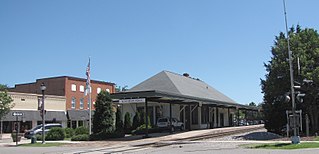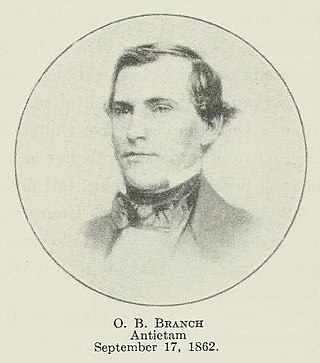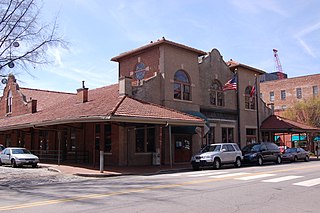
Southern Pines is a town in Moore County, North Carolina, United States. The population was 12,334 as of the 2010 United States Census.

Thomas Blount was an American soldier, and politician. He served as a lieutenant in the North Carolina Line and as an adjutant general to Major General Richard Caswell in the North Carolina militia during the American Revolutionary War. After the war, he served as a representative in the North Carolina General Assembly and served three terms in U.S. representative from the 5th Congressional District in North Carolina.

Lawrence O'Bryan Branch was a North Carolina representative in the U.S. Congress and a Confederate brigadier general in the American Civil War, killed at the Battle of Antietam. He owned 40 slaves.

Bath Historic District is a historic district in Bath, Beaufort County, North Carolina. The district is now a North Carolina Historic Site belonging to the North Carolina Department of Natural and Cultural Resources and known as Historic Bath, and includes a visitor center offering guided tours of the Bonner House and Palmer-Marsh House, which is also a National Historic Landmark. Visitors can also tour the Van der Veer House and St. Thomas Episcopal Church.

Christ Episcopal Church, also known as Christ Church on Capitol Square, is an Episcopal church at 120 East Edenton Street in Raleigh, North Carolina. Built in 1848–53 to a design by Richard Upjohn, it is one of the first Gothic Revival churches in the American South. The church was built for a parish established in 1821; its minister is the Rev. James P. Adams. It was declared a National Historic Landmark in 1987.

The Moore Square Historic District is a registered historic district located in downtown Raleigh, North Carolina. Listed on the National Register of Historic Places in 1983, the district is centered on Moore Square, one of two surviving four-acre parks from Raleigh's original 1792 plan. The park is named after Alfred Moore, a North Carolina judge who became an Associate Justice on the Supreme Court. Originally a residential neighborhood, Moore Square developed into a primary commercial hub in the city throughout the late 19th and early 20th centuries. The district includes East Hargett Street, once known as Raleigh's "Black Main Street", because it once contained the largest number of businesses owned by African-Americans in the city. City Market, Marbles Kids Museum/IMAX theatre, Pope House Museum, Artspace, and the Long View Center are located in the Moore Square district. Events that take place in Moore Square include the Raleigh Arts Festival, Artsplosure, Movies in the Park, the Street Painting Festival, and the Moore Square Farmer's Market The approximate district boundaries include Person, Morgan, Wilmington, and Davie Streets.
Moore House or Moore Farm may refer to:

The Carson House is a historic house and museum located in Marion, North Carolina. It was the home of Col. John Carson, and served as the McDowell County courthouse when the county was first organized in 1842.

This list includes properties and districts listed on the National Register of Historic Places in Moore County, North Carolina. Click the "Map of all coordinates" link to the right to view a Google map of all properties and districts with latitude and longitude coordinates in the table below.
Albert Gamaliel Jones was a notable "house carpenter" from Warren County, North Carolina. He built "distinctive" Greek Revival plantation houses and college buildings.

The House in the Horseshoe, also known as the Alston House, is a historic house in Glendon, North Carolina in Moore County, and a historic site managed by the North Carolina Department of Natural and Cultural Resources' Historic Sites division. The home, built in 1772 by Philip Alston, was the site of a battle between loyalists under the command of David Fanning and patriot militiamen under Alston's command on either July 29 or August 5, 1781. The battle ended with Alston's surrender to Fanning, in which Alston's wife negotiated the terms with the loyalists.
The Moore-Holt-White House was a historic home located in Burlington, North Carolina. It was built in 1859, and was a vernacular Greek Revival-style dwelling consisting of a main two-story front block one room deep with a porch across the front. It was one of only a few antebellum houses surviving in Burlington.
Moore-Manning House is a historic home located at Pittsboro, Chatham County, North Carolina. It was built in the 1830s, and is a two-story, three-bay, Federal style frame dwelling with a hipped roof. The house was renovated in 1858 and a two-story wing added.
Locust Lawn is a historic tobacco plantation house and national historic district located near Oxford, Granville County, North Carolina. It was built about 1855 by Armistead Ravenscroft Burwell, a descendant of the prominent Burwell Family of Virginia and is a two-story, three-bay, T-shaped Greek Revival style dwelling. It has a two-story rear ell, one-story kitchen wing, brick cellar and central front porch. Also on the property are the contributing six log tobacco barns, two frame barns, frame corncrib, overseer's house, and Burwell Family cemetery.

James Bryant House is a historic home located near Harris Crossroads, Moore County, North Carolina. It is dated to about 1820, and is a two-story, three-bay, single-pile frame farmhouse. It rests on a fieldstone pier foundation, has a gable roof, shed porch, and rear shed rooms. The house has been restored. It was added to the National Register of Historic Places in 1982.

Shaw House, also known as the Old Shaw Homestead, is a historic home located near Southern Pines, Moore County, North Carolina. It is dated to the early-19th century, and is a 1+1⁄2-story, three-bay, frame dwelling with Federal / Greek Revival style design elements. The house has massive, single-shoulder, dressed sandstone and brick end chimneys, a gable roof, and full-width engaged front porch. It has a rear ell added in the late-19th or early-20th century. Shaw House is thought to be one of the oldest surviving houses in Moore County.
Benvenue is a historic plantation house located near Rocky Mount, Nash County, North Carolina. Originally built in 1844, the house was expanded and extensively remodeled to its present Second Empire form in 1889. It is a large 2+1⁄2-story, three bay by three bay, frame dwelling with a one-story rear ell. It features a steep mansard roof with imbricated and floral patterned slate tiles. Also on the property are the contributing frame kitchen, dovetailed log rootcellar, frame dairyhouse, smokehouses, commissary, a restored greenhouse, spring house, and a one-room schoolhouse. It was the home of Congressman Benjamin H. Bunn (1844-1907).

Davenport House is a historic homestead located on Mount Tabor Road in Creswell, Washington County, North Carolina. It was built about 1815, and is a 1+1⁄2-story, heavy timber-frame cottage. The layout of the house is a one-room core and an engaged porch with a rear shed room and features a broken-slope roof. The architecture of the home is classified as a "coastal cottage" in North Carolina regional architecture. Few examples of this style of home have survived, but similar one-room core historic homes include Purefoy-Chappell House and the Cullen and Elizabeth Jones House. It is the oldest homestead available for public viewing in the region. The homestead is part of the estate of Daniel Davenport, the first representative to the North Carolina Senate from Washington County.. The house itself is presumed to have been built by his daughter, Asenath Davenport.

Thomas B. Finley Law Office, also known as the J. F. Jordan Law Office, is a historic law office located at Wilkesboro, Wilkes County, North Carolina. It was built during the early 1880s, and is a small one-story frame building one room wide and two deep. It has sawnwork bargeboards and decorative finials in the Carpenter Gothic style. It is owned by the Wilkes Heritage Museum.

The Moore House is a historic house at 20 Armistead Street in Little Rock, Arkansas. It is a 2+1⁄2-story rambling brick structure, built in 1929 to a design by Thompson, Sanders & Ginocchio. It has stylistic elements of the Tudor Revival then popular, including a tile roof, cross-gable above the main entrance, clustered chimneys with corbelled detailing, and asymmetrical arrangements of mostly casement windows. The house was listed on the National Register of Historic Places in 1982.

















